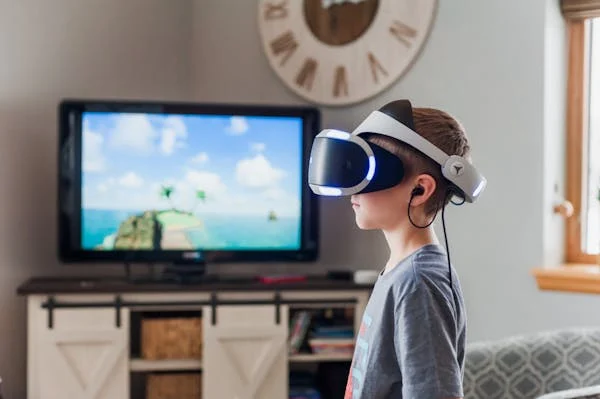The integration of Augmented Reality (AR) and Virtual Reality (VR) into the realm of interactive exhibits is revolutionizing the way we experience and engage with information. From museums to trade shows, these cutting-edge technologies are enhancing user experiences, making them more immersive, educational, and engaging. This article delves into how AR and VR are transforming interactive exhibits, exploring their benefits, applications, and future potential.

The Evolution of Interactive Exhibits
Interactive exhibits have come a long way from simple touchscreens and static displays. The advent of AR and VR has pushed the boundaries of what is possible, offering a more dynamic and interactive way to present information. These technologies allow for the creation of lifelike simulations and interactive environments that can respond to user input in real-time.
Benefits of AR and VR in Exhibits
Enhanced Engagement
One of the primary benefits of AR and VR in exhibits is the enhanced level of engagement. These technologies capture the attention of visitors more effectively than traditional methods. By providing an interactive and immersive experience, users are more likely to spend time exploring the exhibit and absorbing the information presented.
Educational Value
AR and VR can significantly enhance the educational value of exhibits. They allow for complex information to be presented in an easily digestible format. For instance, a VR simulation can take visitors on a virtual tour of ancient civilizations, while AR can overlay detailed information on historical artifacts, providing a richer learning experience.
Accessibility
AR and VR make exhibits more accessible to a broader audience. For example, virtual tours can be offered to those who cannot physically visit an exhibit, while AR can provide real-time translations and information for non-native speakers, making the exhibit more inclusive.
Applications of AR and VR in Interactive Exhibits
Museums and Cultural Institutions
Museums are at the forefront of adopting AR and VR technologies. These institutions use VR to create virtual tours of exhibits, allowing visitors to experience them from anywhere in the world. AR applications enable interactive guides that provide detailed information about exhibits, enhancing the visitor experience.
Trade Shows and Exhibitions
Trade shows and exhibitions are leveraging AR and VR to showcase products and services in innovative ways. VR can simulate real-world scenarios where products can be tested, while AR can provide interactive product demonstrations, making it easier for potential customers to understand the features and benefits of what’s on offer.
Educational Institutions
Schools and universities are using AR and VR to create interactive learning environments. These technologies make it possible to conduct virtual field trips, anatomy lessons, and historical recreations, providing students with a hands-on learning experience that is both engaging and informative.
Future Trends in AR and VR for Exhibits
Increased Interactivity
The future of AR and VR in exhibits lies in increasing interactivity. Developments in haptic technology, which allows users to feel virtual objects, will make VR experiences even more immersive. Similarly, advances in AR will enable more seamless integration with the physical world, enhancing the interactivity of exhibits.
Personalized Experiences
AR and VR will enable more personalized exhibit experiences. Using AI and machine learning, these technologies can tailor the exhibit content to the interests and preferences of individual users. This personalization will make exhibits more engaging and relevant to each visitor.
Hybrid Experiences
The future will likely see a blend of physical and virtual exhibits. Hybrid experiences that combine the tactile nature of physical exhibits with the immersive aspects of AR and VR will become more common, offering the best of both worlds.
Conclusion
AR and VR are undoubtedly transforming the landscape of interactive exhibits. These technologies offer unparalleled opportunities for engagement, education, and accessibility, making exhibits more dynamic and inclusive. As AR and VR continue to evolve, we can expect to see even more innovative applications that will further enhance the way we experience and interact with information.
FAQs
1. What is the difference between AR and VR?
AR overlays digital information onto the real world, enhancing the user’s perception of reality, while VR creates a completely immersive digital environment that replaces the real world.
2. How do AR and VR enhance educational exhibits?
AR and VR make educational exhibits more engaging by providing interactive and immersive experiences that help users better understand complex information through simulations, virtual tours, and interactive guides.
3. Can AR and VR exhibits be accessed remotely?
Yes, VR exhibits can be accessed remotely, allowing users to experience them from anywhere in the world. AR exhibits can also be enhanced with remote access features, providing real-time information and translations.
4. What are some examples of AR and VR applications in museums?
Examples include virtual tours of exhibits, AR-guided tours with detailed information on artifacts, and interactive displays that allow visitors to engage with historical recreations or scientific simulations.
5. What future advancements can we expect in AR and VR exhibits?
Future advancements include increased interactivity through haptic technology, more personalized experiences using AI and machine learning, and the development of hybrid experiences that combine physical and virtual elements.